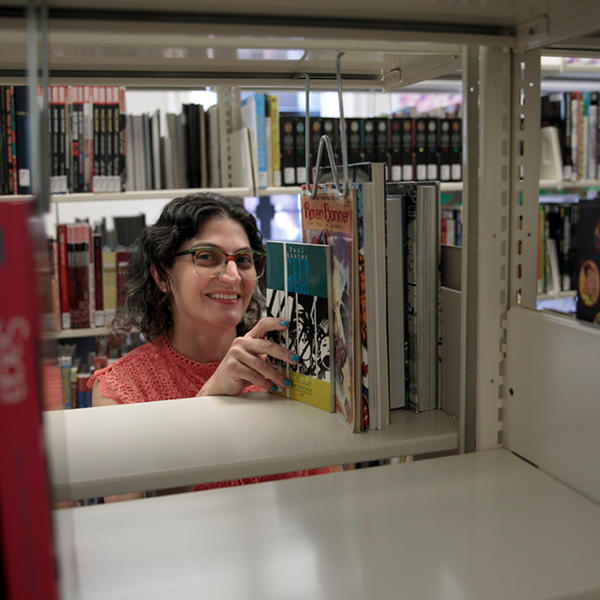No one within the College of the Holy Cross’ English Department today has taught longer on Mount St. James than Susan Elizabeth Sweeney, Distinguished Professor of Arts and Humanities. One of her favorite topics to share with students is detective fiction, including Paul Auster's 1985 novella, "City of Glass."
About 15 years ago, Sweeney stopped using the original work in her class, instead replacing it with the adaptation “City of Glass: The Graphic Novel” by Paul Karasik and David Mazzucchelli.
Since then, Sweeney has incorporated more graphic novels in her courses and said the results have sparked some of the most impressive work she’s seen at Holy Cross.
“I’ve taught English at Holy Cross forever,” Sweeney said. “I’ve assigned many, many English papers and it’s always a struggle to come up with assignments that are interesting for the students to write and interesting for me to read. Graphic novels have been really useful for that.”
In one assignment, her students had to plan their own graphic novel adaptation and write a query letter proposing it to a publisher.
The complexity of graphic novels originally attracted Sweeney after she shrugged off the comics genre as a child; reading text while looking at illustrations felt more like a chore than an enjoyable experience.
Enter “City of Glass.” With its sophisticated use of text bubbles to communicate speech patterns for a character forbidden to speak as a child, Sweeney realized that good graphic narrative can do things other media cannot.
“It’s very complex,” she said. “It’s like patting your head and rubbing your stomach at the same time. Intellectually, it’s a little difficult.”
Sweeney isn’t alone in her assessment of the value of comics in the classroom. She partnered with Susan Schmidt, associate professor of visual arts, to use graphic novels as part of a Montserrat course for first-year students.
“It’s a way to learn about drawing and how drawing interacts with narrative,” Schmidt said. “Graphic novels are really drawings in little boxes. They are very abbreviated and abstract. In order to communicate a complex idea, you have to simplify it.”
Professors across a variety of Holy Cross departments, from English to Spanish, art to history, find immeasurable value in the literature that just a few decades ago — and to some, still today — was considered or even mocked as juvenile.
“Comics in the classroom, I think especially for literature or art majors, help students learn how to understand, comprehend and come to terms with an art form that they may not be familiar with,” said Jorge Santos, associate professor of English. “And in doing so, it may sharpen the ways they are familiar with. You become a better reader of film, prose and poetry by reading comics because they’re all in the same cultural soup. They’re all lending and borrowing from each other.”
College comics collection continues to grow
Dinand Library is home to more than 3,000 comics as part of the Dr. Mark D. Nevins ’86 Collection for the Study of Comics and Graphic Novels. Titles range from Charles Schultz’s “Peanuts” to Art Spiegelman’s Pulitzer Prize-winning Holocaust memoir “Maus,” to Alison Bechdel’s lauded “Fun Home,” to shelves full of superheroes. The graphic novels explore history, biography, social issues and civil rights, science and the experiences of marginalized groups.
Janis Desmarais, visual literacy and arts librarian at Dinand, has managed and helped the collection grow since 2018 when Nevins donated more than 1,500 graphic novels to the College to jumpstart a collection. At Holy Cross, Nevins was a member of the Honors Program and a Fenwick Scholar, the highest academic honor the College can bestow on a student. He graduated cum laude with a degree in English and later earned a master’s and Ph.D. from Harvard University.
Since his original donation, Nevins and Desmarais have worked to more than double the collection in size — and it’s about to more than double again.
James Wu, a close friend of Nevins, died suddenly in 2020. Nevins worked with Wu’s family to direct Wu’s collection of more than 3,200 graphic novels to Dinand’s collection.
“Losing my dear friend James was crushing, but seeing his collection joining mine at Holy Cross, and available to the students and faculty, is a beautiful thing” Nevins said. “James was one of the greatest teachers I’ve ever known, and I am sure he’s looking down at Holy Cross now and smiling.”
“By adding these kinds of collections it reduces the barriers to influential thought,” said Mark Shelton, director of library services. “It reduces the barriers to creative opportunity. It reduces the barriers to how and where the potential student can go. We know the value of a liberal arts education is that you get this broad exposure to lots of different ways of thinking, lots of different views, ideas and opinions. Then it’s put in the hands of the student.”



